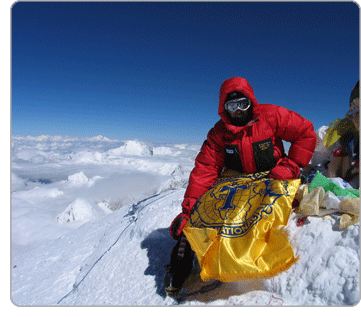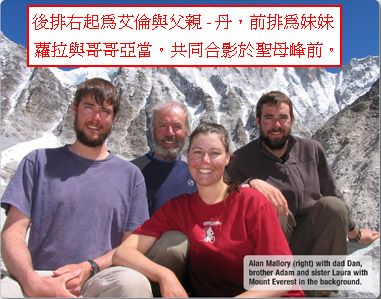| 翻譯委員會公告事項 |
|
本項翻譯係經世界總會授權,版權亦屬世界總會及中華民國國際演講協會所有, |
|
|
站在世界的頂端 |
|
|
|
譯者:陳立山 Solomon, Wheelers |
|
Standing On Top of the World 作者:Suzanne Frey |
|
 |
 |
|
Canadian Toastmaster Climbs Mount Everest 加拿大國際演講會員登上聖母峰 |
|
|
“It’s not the mountain we
conquer; it’s ourselves.”
– Sir Edmund Hillary By Suzanne Frey 作者 蘇珊•佛瑞
On May 25, 2008, Alan
Mallory, a 23-year-old Toastmaster from Barrie, Ontario, Canada, stood
on the summit of the world’s highest mountain and thought, “I can’t wait
to get down.”
It was a clear day with an
incredible view of the neighboring Himalayan peaks. But the temperature
was minus 40 degrees and he was exhausted and cold, mindful of the fact
that reaching the summit was only half the battle. He still had to get
down safely.
Alan was accompanied on the
narrow and steep summit by his father, Dan, and his older brother, Adam,
25. Before heading down, he did what any serious mountaineer would do:
He posed for pictures, exposed his bare hands to the cold wind and
filmed the view. He also did what most mountaineers would not do: He dug
deep into his backpack for his club’s 3-by-4-foot Toastmasters flag,
tried to unfurl the large banner in howling winds so the text would be
visible, and posed for more photos. (See cover image.)
“If only you knew how long
we stood there, in the freezing cold at the elevation of a jetliner’s
cruising altitude, trying to shoot this banner before the wind furled it
again,” chuckled Dan, Alan’s dad. “Most people stay a few minutes on the
summit; we must have stayed 40 minutes.”
Climbing Mount Everest is
an in incredible physical and mental challenge. No rescue is possible at
its higher elevations, so climbers must bring emergency gear. Space is
limited in a backpack that averages 50 pounds in weight and includes
precious oxygen tanks to help with breathing in the thin air. As a
result, climbers go to extreme lengths to shave off ounces, including
removing labels from clothing and cutting toothbrushes in half. The Port
Credit Toastmasters banner took up valuable space and weight in Alan’s
pack. Why did he bring it? “It was left in my bag, and on summit day I
thought I might as well bring it,” he says with a shrug.
The Toastmasters banner
must have brought good luck to Alan, his brother and father. They all
returned safely to base camp, but not without a scare: Alan had
forgotten to turn off his oxygen while at the summit, and as a result
ran out of air when he needed it during a crucial point in the descent.
He started to panic when after borrowing an oxygen cylinder from a
Sherpa, he still couldn’t breathe, and feared the onset of cerebral
edema, a potentially fatal condition in which blood leaks into the
brain. Too weak to hold onto the rope, he risked falling off the
7,000-foot vertical drop on either side of the summit ridge.
Fortunately, his dad found that the oxygen valve had been accidentally
closed, and when opened, Alan could breathe – and move – again.
More Family Feats
Alan’s mother, Barbara, had
also ventured with her family all the way to Everest base camp, but fell
during a training climb and tore her Achilles tendon. She returned home
to Barrie, Ontario, where she supported her family by posting blogs on
their progress.
Alan, drawing on his
Toastmasters skills, now gives presentations about the Everest
experience. He uses the family’s adventure to inspire others to achieve
their own goals. Says fellow Port Credit club member and former District
Governor Janice Weir, DTM: “Alan’s journey is a perfect metaphor for
Toastmasters itself: reaching for the top, scaling new heights, getting
out of your comfort zone, and then feeling on top of the world when you
achieve your goals.”
At 29,035 feet (8,850
meters) elevation, Mount Everest has long been the object of
inexplicable passion for climbers. Since Edmund Hillary first climbed it
in 1953, this peak has been the subject of movies and books, as well as
the site of many tragedies. Approximately 180 people have died trying
to scale its icy slopes. Rock falls, avalanches and crevasses, altitude
sickness and weakness brought on by inability to eat, are among many
challenges that test climbers’ limits on Everest. Yet they pay
approximately $65,000 per person for the opportunity to do so. They
endure months of painful acclimatization training – all for a chance to
enter what’s commonly known as the “Death Zone” and for a few brief
moments stand on top of the world.
Why do they do it? It was
British mountaineer George Mallory (who reportedly reached the summit of
Everest before Edmund Hillary did, but died on the descent), who
famously said, “If you have to ask the question, you won’t understand
the answer.”
For the Mallorys (no
relation to George Mallory), it all started with an idea proposed by
Alan’s dad over dinner: “Who wants to climb Mount Everest?” While most
families would laugh this off, the Mallory family did not. Besides
sharing a surname with George Mallory, this family thrives on
adrenaline. Instead of lounging on beaches, the Mallorys spent holidays
camping and climbing, and trained together for the Everest climb by
entering endurance races.
“We are an ordinary family
who had a collective and daring dream,” Alan says. “We followed through
and we made that dream come true.”
As the family contemplated
its Everest plans, Alan graduated from Queens University in Kingston,
Ontario, and started his job as a mechanical engineer. An athlete and
avid outdoors adventure seeker, he was an experienced climber who had
already reached the summit of Alaska’s challenging Mount McKinley. To
climb Everest, he had to request a leave of absence for two and a half
months from his new job. His employer not only granted his request; the
company, an engineering company called Hatch, sponsored a portion of the
trip.
Making Memories...and
Conversation
Alan also acknowledges that
the family’s Everest adventure “opened a lot of doors for me.” Having
joined a Toastmasters club while still in college, he is the family’s
spokesman, fielding requests from all over the world to share their
adventure with a wide range of audiences. Complete with extraordinary
photos and video clips, Alan’s presentations highlight “how
goal-setting, teamwork and pushing beyond perceived limitations can
help audience members achieve their dreams.”
Alan joined Toastmasters
because he felt he needed better communication skills in his future
career as an engineer. “I like to try new things, to get involved and
get better at what I’m doing,” he says. After graduation, he moved to
Mississauga, Ontario, and joined the Port Credit Toastmasters club. A
job transfer brought him to his current club, To the Point
Toastmasters, in Kincardine, Ontario. “Toastmasters skills help you out
with everything in life,” he says.
His employer, Hatch, has
hired Alan to speak at many of its corporate events and sponsors several
Toastmasters clubs as a result of Alan promoting the benefits of
membership.
Past District Governor Weir
says Alan is “an excellent and captivating orator. He is modest and
unpretentious; listening to him tell his Everest story is like
listening to a friend tell you about his weekend.”
Would Alan return to Mount
Everest or another 8,000-meter peak? He laughs. “No, I’m not going
anywhere near there; it’s just too painful.” But he’s grateful for the
experience: “I enjoy the challenge of doing something not many people
have done.”
His next challenge?
Marriage. Alan tied the knot in August.
“That’s going to be a
harder challenge than climbing Everest.”
You can read more about the
Mallory family’s Everest adventure at
www.malloryexpedition.com.
Suzanne Frey
is the editor of the Toastmaster magazine and a member of
Unimasters Toastmasters club in Lake Forest, California |
|